Matthew Streger used a Treo for years. He has switched over to the BlackBerry OS after experiencing many issues with his Treo. He has written a comparison of the BlackBerry and Treo. Part I of Matthew's article can be read over at our sibling site CrackBerry.com. Here is Part II of Matthew's comparison.
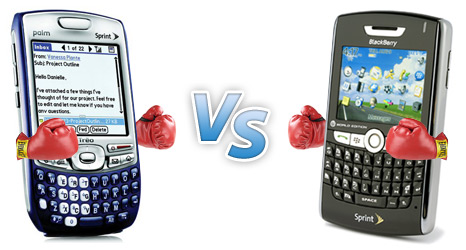
In Part I of this article, I reviewed the differences between the Blackberry and Treo platforms in hardware and operating system. I gave a significant edge to the Blackberry for newer and more functional hardware and a much more stable operating system. This is only half of the decision though. What you are ultimately going to do with your handheld will really decide which device is right for you.
Information Management
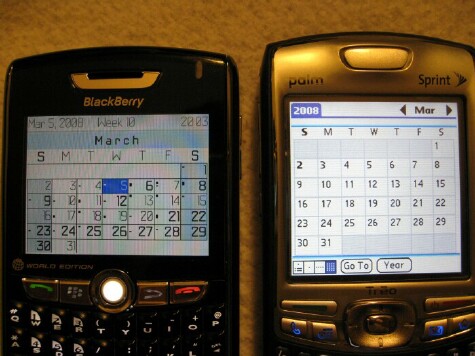
Calendar – The Palm OS native information management programs are far superior to the Blackberry’s. I believe this goes back to the Palm OS roots – remember, it was originally designed for this function exclusively, and the e-mail, internet and telephony functions were layered on top many years later. The Palm simply offers easier data entry, manipulation and options for viewing. If you want to add colors, or icons, or customize the different calendar views, Palm OS is for you. In fact, one of the more glaring omissions of the Blackberry calendar is the inability to categorize entries. That being said, the Blackberry calendar is functional, if not overly easy to use. You can certainly enter and edit calendar entries, and you can view them in a daily, weekly, monthly and agenda view.
Contacts – The address book function is probably a draw. There really are not that many things you can do with the core contact information management. You can categorize entries on both devices, and filter them as needed. Both operating systems offer the standard range of customized contact information, such as work / home / mobile numbers and multiple e-mail addresses. Both devices utilize the address book as the primary cellular “phone book”, which is an enormous advantage of Smartphones in general. As there isn’t much difference between them, I consider this area a tie as well.
Tasks – Unlike many people, I literally live and die on my task list. I think I grew to love this function from my days as an early Palm adopter, and because I am a “list-maker.” I have daily to-do lists, project lists, follow up lists, telephone call lists, long-term lists, and more. I think the best program for utilizing this function is by far the Palm Desktop, which I used for many years before moving to Outlook. Palm Desktop allows you to prioritize tasks on a scale of 1-5, rather than the high-normal-low priority that Outlook (and therefore most other systems) use. That being said, the Blackberry’s task program is fairly meager. It does the minimum functions of sorting, displaying and editing tasks, but it’s not easy to use, and it is difficult to customize. The Palm OS program is much better for this function.
Notes – On the other hand, this is one area that I use infrequently at best. Much like the contacts features above, the notes/memos functionality is pretty basic on both devices. You can create and edit short text memos that you synchronize into Palm Desktop or Outlook. Neither system will allow reading or editing of native text files, or any other documents for that matter. I see many people trying to use their handhelds as ultra-portable laptop computers, creating and editing Office applications, but that exceeds the intent of these devices (in my opinion) and certainly exceeds the scope of this review. Again, like contacts, this is a draw.
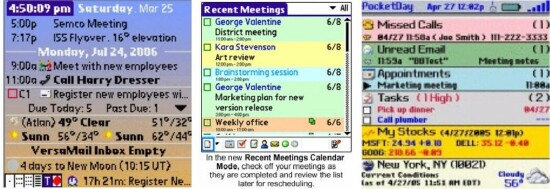
Third-Party Applications – Where the native applications fail, you can always install third-party programs to fill in the gaps on both platforms. Here, as noted previously, the Palm has somewhat of an advantage in the variety and depth of the software. On the Palm OS, you have options such as Datebk6 (which was Datebk3 when I registered it), or Agendus for full-featured PIM replacements. I previously used 2Day, a great simple program to display today’s “critical” information. There are many others on Palm of varying functionality and price. For the Blackberry, there are simply not as many options, and that is probably rooted in the origins of the devices I noted above. There is a decent “today” program in PocketDay, but it’s not as good as any of the Palm programs. Similarly, there is BBTaskPro for task management, but there really isn’t a good Datebk6 or Agendus type of program for the Blackberry. I believe this is due to the limitations of the OS rather than the lack of need, desire or competent programmers, but in third-party programs, as with all PIM functions, the edge goes to the Palm OS.
Email Management
Where the Palm OS shines in personal information management, the Blackberry shines in e-mail. This is probably because the Blackberry grew up on e-mail. That is not to say that it is without flaws, but they are annoyances rather than deal-breakers, and I have confidence moving forward that they will be corrected over time. With regard to the Palm OS and the Treo, I do not have that confidence.
First, one caveat. This review is limited to Blackberry Internet Service (BIS) and not Blackberry Enterprise Server (BES). BIS is for the majority of us who operate our Blackberry as a personal device – this is the system that allows us to get our Gmail, Yahoo or other e-mail on the Blackberry. BES is the (very expensive) “behind the scenes” program that allows seamless wireless synchronization of your e-mail, calendar, contacts, etc. to Microsoft Exchange Server. If your company gave you a Blackberry, and you synchronize to Outlook, BES is probably the system that you are using. BES is the gold-standard for Blackberry e-mail, but if you’re reading this you are probably making a purchasing decision for yourself and not your company, so you are probably going to use BIS.
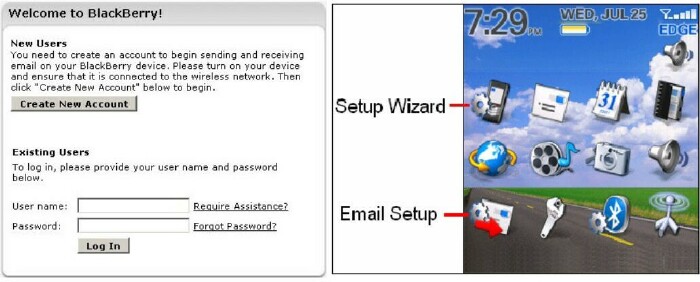
Setting up e-mail on BIS may be the easiest thing IÂ’ve ever done on a computer. You donÂ’t need to know any settings, or what kind of system you are on, or really anything else besides your e-mail address and password. You go to the web page of your cellular provider, navigate to their BIS gateway, and set up a personal account for the first time. After that, you simply provide the basic e-mail address and password for your e-mail accounts and it does the rest. It figures out the system you are on (POP, IMAP, Outlook Web Access), configures itself, downloads the data to your device, and you start getting e-mail. ItÂ’s that easy.
Compare this to the process of setting up wireless e-mail on a Treo. Versamail is an abomination of a program. It requires you to tweak numerous settings to get your e-mail, has severe limitations on functionality (Exchange Active Sync only does mail, contacts and calendar, not tasks and notes), and it has horrible functionality. Versamail crashed my Treo countless times, and when it was not crashing it duplicated entries or corrupted data. I got so fed up with Versamail that I switched to Chatteremail, which is a wonderful stand-alone POP and IMAP program. Chatter used to be the best option out there for Palm devices until Palm bought the program, employed the developer, started to sell the program on the Palm website, and then immediately discontinued all future development and virtually all support. When it worked, Chatter was perfect – you got literally instant delivery of IMAP e-mail, true bi-directional synchronization of sent and deleted items, and access to all of your IMAP folders. Unfortunately, besides eating through your battery as noted in Part I, configuring it was a nightmare, and if you had any problems, you were essentially up the creek. For example, my company has great tech support, but when we migrated from Exchange Server 2003 to 2007, Chatter stopped accessing my e-mail. Our IT staff couldn’t figure it out, and there was no support, so we ended up coming up with a work-around that we should have never had to implement to begin with. Plus, I am convinced that many of my crashes were based in Chatter – it ran in the background, but because the Palm OS does not truly multi-task, it ran into problems when trying to pull down a message with anything else going on. As I noted above, these crashes were a major factor in my decision to abandon the Palm OS.
This is not to say that the Blackberry is completely without problems. For example, I am accessing three e-mail accounts through BIS (you can have up to ten). One is my work’s Exchange Server that I access through Outlook Web Access. One is a Gmail account I have configured for IMAP for push email and bi-directional synchronization of sent and deleted items. The third is a Gmail POP account I use only for delivery of voice mail messages (I use Simulscribe, which is a great system). The POP delivery is instant, but is limited by POP functionality, namely no synchronization of deleted or sent items. Unfortunately, my work’s OWA account and personal Gmail IMAP account do not synchronize the way I expect them to. First, there is a delay in delivery of my work’s OWA e-mail that runs up to ten or fifteen minutes. This appears to be a limitation of BIS – it only polls e-mail servers every fifteen minutes, then more often after a message arrives, then back down to the default fifteen minutes. It is annoying for me to wait this time for e-mail messages, and for even longer (up to hours) for the full e-mail reconciliation of deletes to occur. For some people, this might be a deal-breaker, but nothing that I do requires truly instant e-mail delivery. My Gmail IMAP account had some delays in delivery, but working with some of the great people at crackberry.com helped me fix that by removing and restoring that account. However, there seems to be some limitation in the IMAP synchronization from the Gmail server to the device not marking items read or archived. Plus if you delete a message on the Blackberry, it actually deletes it on Gmail rather than archiving it. This is a little more than an annoyance, as it defeats the purpose of Gmail’s permanent e-mail storage. Also, Blackberry e-mail is limited to plain-text only without HTML formatting, but this feature is supposed to change with an upcoming operating system update.
One more little note – Blackberry delivers all e-mail through their servers, no matter who your e-mail provider is originally. I could not find a program that accesses POP or IMAP e-mail directly on the Blackberry platform, as I thought this might help alleviate some of my delivery and synchronization issues. This is part of what makes setting up a Blackberry so easy, but when Blackberry’s system crashes, you lose your e-mail. Blackberry users are very sensitive to this issue, as it happened recently and made national news. I think we all run into this risk with our technology, but it is something to consider.
In the end, my choice was instant e-mail delivery and synchronization with constant crashes, or delays and inconveniences with total platform stability. For my purposes, I chose the Blackberry for stability. I also have some degree of confidence that Blackberry (and perhaps Google with them) will work to fix some of these issues, much as they are fixing the HTML issue. I have no confidence whatsoever in Palm to make any improvements in my experience. In fact, Palm demonstrated with Chatteremail that they could purchase a viable and functional piece of software and stop development and support, essentially removing one of the best options out there. You should look at the pros and cons of both platforms and decide what is most important for your needs before selecting between Palm and Blackberry. For me, the edge definitely goes to Blackberry.
Telephony
I cannot spend too much time comparing these devicesÂ’ ability to make telephone calls as there really is not that much difference between them. Your telephone experience is probably based much more on the network you use and your cellular provider than it is impacted by the choice between Palm and Blackberry devices. That being said, there are a few noteworthy differences, none of which will probably make your final decision between devices.
Besides my (extensive) comments throughout this article on the stability of the Blackberry compared to the instability of the Treo, the Bluetooth functionality of the Treo has always been a nightmare. The 700p had many problems with dropped connections, interference and incompatibilities. The 755p was virtually identical to the 700p with regard to Bluetooth problems. The Bluetooth on the Blackberry 8830, on the other hand, works perfectly. It stays connected, has good audio quality, and even has integrated voice dialing.
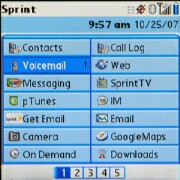
The Treo does offer one function that I miss desperately on my Blackberry, though. The Blackberry has 26 speed dial slots, one for each letter of the alphabet. You push and hold the letter for the person you want to dial, but hopefully you can remember who you assigned to the “Q” key because it’s not so easy to pull up the screen that lists the speed dial entries. In addition, you are limited to only speed dialing telephone numbers and not programs or web sites. The Treo speed dial application is easier to access and offers much more in the way of functionality. I do wish I could do this on my Blackberry (hint, hint Blackberry developers).
Internet
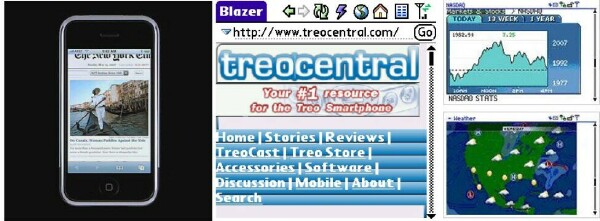
Internet access on both devices is certainly not their forte. If you really want a great handheld internet experience, and thatÂ’s the primary reason for your decision, you probably want an iPhone. Both the Palm and Blackberry have small screens and limited browser functionality, but for basic internet access I think they are fine. I have read many comments about the poor quality of the Blackberry browser, but for basic browsing I think it is acceptable, and actually better than the Blazer browser that comes on the Treo for speed and stability. I actually donÂ’t mind the trackball navigation on the Blackberry browser as it works fairly intuitively, but itÂ’s still best to stick to mobile-formatted sites. I installed Opera Mini on both devices, and for non-mobile optimized sites it works fairly well. I did find Opera faster and more stable on my Blackberry than on my Treo, though.
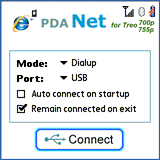
One last function for internet access is using the device as a cellular modem for a laptop. On my Treo, I registered PDANet, a great and reasonably-priced program that allows the Treo to get my laptop online from locations that lack a WiFi connection (like my fiancée’s mom’s house). It is a one-time registration, and it worked fairly well, as long as you don’t pull down too much data. You see, it’s not technically within the terms of service with your cellular provider to use the Treo as a modem. On the Blackberry, I had to pay $10 a month for the “tethering” package on Sprint to be able to do this (actually, I traded access to the horrible Sprint Telenav program for tethering). I found the speed and stability a bit better on the Blackberry’s tethering system as well, but it ends up being more costly over time.
Support
One of the most annoying things of using a Smartphone is that your technical support is primarily through your cellular provider, and you all know how responsive and knowledgeable the typical customer service representative is. That being said, my primary avenue of support is usually online forums such as this one, and for that reason I usually know more than the technical support person does. I doubt youÂ’ll get a really good tech support person on any cellular provider who knows more than the basics for either the Blackberry or Treo.
However, on the topic of long-term platform support, I believe that the Palm operating system is stagnant if not dying. Palm simply has not innovated in any way in its hardware or software in years, and it continues to offer sub-par solutions. I agree that both Palm and Blackberry have issues, some of which are important and some of which are annoyances. However, with the larger issues, I have no confidence in Palm to address them. Palm has had ample time to fix things like stability, wireless e-mail and Bluetooth, and seemingly hasnÂ’t done so as of yet. In fact, when I had my 700p, Palm released an operating system patch that bricked numerous telephones and made others worse than they originally were. I no longer trust Palm to provide me with a hardware or software solution for my personal needs going forward.
In comparison, I do have some confidence in Blackberry to address the issues that I have. They are already coming out with an operating system update that offers HTML e-mail, and I do have confidence that things like the e-mail delivery and synchronization delays will get better. I agree that the e-mail crashes that take down their entire network are difficult to deal with, but they are rare, and no technology works 100% of the time.
Conclusions
I think in the end, the strengths and weaknesses of the Treo compared with the Blackberry are based on where they began. The Palm platform began as the best personal information management system in personal computing history. It was originally designed to handle calendar, contacts, tasks and memos. Everything else with the Palm was gravy – the connectivity and tons of other software and accessories all grew from the original primary function of personal information management. In comparison, the Blackberry was originally a mobile e-mail device. In fact, for some time, just like the Palm, it didn’t have a telephone.
Today, the Palm is still better at the core information functions – the native applications offer more options for customizing how to view your information. Unfortunately, this is at the expense of handling telephone calls and e-mail messages very badly. The Blackberry isn’t nearly as good at personal information management or customization, but it does an adequate job, it’s much more stable, and in the end I have some degree of confidence that the Blackberry will continue to evolve and fix many of my issues. I do not have any confidence in Palm any longer, and that’s the ultimate reason for my switch.
Matthew R. Streger, Esq., is an attorney/paramedic based in New Jersey specializing in health care litigation.
Discuss Treo vs. BlackBerry here in our forums.